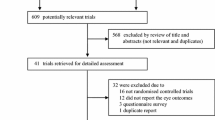Abstract
To investigate the role of radioactive iodine (RAI) in the onset and progression of thyroid-associated ophthalmopathy (TAO). Forty-six Graves’ disease patients with mild or no ophthalmopathy were prospectively treated with carbimazole (CBZ) (n = 22) or RAI (n = 24). Treatment effects were evaluated clinically over 12 months, and with orbital MRI-measured extra-ocular muscle (EOM) volumes at baseline and at 6 months. The diagnosis of TAO was based on the clinical activity score (CAS) system. There were 11/22 CBZ and 10/24 RAI patients with active ophthalmopathy at baseline. Despite greater mean TSH levels post-RAI (P = 0.003), there was no increase in the likelihood of developing active ophthalmopathy (OR 0.95; 95% CI 0.56–1.61, P = 0.9) or EOM dysfunction (OR 0.52; 95% CI 0.26–1.06, P = 0.074). The increased mean palpebral aperture post-RAI (P = 0.023) and greater mean proptosis in the CBZ group (P = 0.005) were not confirmed when the absolute values of these measurements were examined. There was no association between the treatment received and MRI-measured EOM volumes. In this study, RAI therapy for Graves’ disease did not increase the risk of progression or development of ophthalmopathy in patients with mild or no eye disease at baseline.


Similar content being viewed by others
References
Burch HB, Wartofsky L (1993) Graves’ ophthalmopathy: current concepts regarding pathogenesis and management. Endocr Rev 14:747–793
Tallstedt L, Lundell G, Torring O et al (1992) Occurrence of ophthalmopathy after treatment for Graves’ hyperthyroidism. The Thyroid Study Group. N Engl J Med 326:1733–1738
Bartalena L, Marcocci C, Bogazzi F et al (1998) Relation between therapy for hyperthyroidism and the course of Graves’ ophthalmopathy. N Engl J Med 338:73–78
Gorman CA, Offord KP (1998) Therapy for hyperthyroidism and Graves’ ophthalmopathy. N Engl J Med 338:1546–1547
Werner SC, Coelho B, Quimby EH (1957) Ten year results of I-131 therapy of hyperthyroidism. Bull N Y Acad Med 33:783–806
Calissendorff BM, Soderstrom M, Alveryd A (1986) Ophthalmopathy and hyperthyroidism. A comparison between patients receiving different antithyroid treatments. Acta Ophthalmol (Copenh) 64:698–703
Manso PG, Furlanetto RP, Wolosker AM, Paiva ER, de Abreu MT, Maciel RM (1998) Prospective and controlled study of ophthalmopathy after radioiodine therapy for Graves’ hyperthyroidism. Thyroid 8:49–52
Perros P, Kendall-Taylor P, Neoh C, Frewin S, Dickinson J (2005) A prospective study of the effects of radioiodine therapy for hyperthyroidism in patients with minimally active Graves’ ophthalmopathy. J Clin Endocrinol Metab 90:5321–5323
Sridama V, DeGroot LJ (1989) Treatment of Graves’ disease and the course of ophthalmopathy. Am J Med 87:70–73
Feldt-Rasmussen U, Bech K, Date J, Petersen PH, Johansen K (1982) A prospective study of the differential changes in serum thyroglobulin and its autoantibodies during propylthiouracil or radioiodine therapy of patients with Graves’ disease. Acta Endocrinol (Copenh) 99:379–385
Bartalena L, Pinchera A, Marcocci C (2000) Management of Graves’ ophthalmopathy: reality and perspectives. Endocr Rev 21:168–199
Pinchera A, Wiersinga W, Glinoer D et al (1992) Classification of eye changes of Graves’ disease. Thyroid 2:235–236
Prummel MF, Bakker A, Wiersinga WM et al (2003) Multi-center study on the characteristics and treatment strategies of patients with Graves’ orbitopathy: the first European Group on Graves’ Orbitopathy experience. Eur J Endocrinol 148:491–495
Wiersinga WM, Perros P, Kahaly GJ et al (2006) Clinical assessment of patients with Graves’ orbitopathy: the European Group on Graves’ Orbitopathy recommendations to generalists, specialists and clinical researchers. Eur J Endocrinol 155:387–389
Kung AW, Yau CC, Cheng A (1994) The incidence of ophthalmopathy after radioiodine therapy for Graves’ disease: prognostic factors and the role of methimazole. J Clin Endocrinol Metab 79:542–546
Villadolid MC, Yokoyama N, Izumi M et al (1995) Untreated Graves’ disease patients without clinical ophthalmopathy demonstrate a high frequency of extraocular muscle (EOM) enlargement by magnetic resonance. J Clin Endocrinol Metab 80:2830–2833
Barth A, Probst P, Burgi H (1991) Identification of a subgroup of Graves’ disease patients at higher risk for severe ophthalmopathy after radioiodine. J Endocrinol Invest 14:209–212
Bartalena L, Marcocci C, Tanda ML et al (1998) Cigarette smoking and treatment outcomes in Graves ophthalmopathy. Ann Intern Med 129:632–635
Karlsson FA, Dahlberg PA, Jansson R, Westermark K, Enoksson P (1989) Importance of TSH receptor activation in the development of severe endocrine ophthalmopathy. Acta Endocrinol (Copenh) 121(Suppl 2):132–141
Kriss JP, Pleshakov V, Rosenblum AL, Holderness M, Sharp G, Utiger R (1967) Studies on the pathogenesis of the ophthalmopathy of Graves’ disease. J Clin Endocrinol Metab 27:582–593
DeGroot LJ, Mangklabruks A, McCormick M (1990) Comparison of RA 131I treatment protocols for Graves’ disease. J Endocrinol Invest 13:111–118
Tallstedt L, Lundell G, Blomgren H, Bring J (1994) Does early administration of thyroxine reduce the development of Graves’ ophthalmopathy after radioiodine treatment? Eur J Endocrinol 130:494–497
Gorman CA (1995) Therapeutic controversies. Radioiodine therapy does not aggravate Graves’ ophthalmopathy. J Clin Endocrinol Metab 80:340–342
Gorman CA (1998) The measurement of change in Graves’ ophthalmopathy. Thyroid 8:539–543
Wiersinga WM (1998) Preventing Graves’ ophthalmopathy. N Engl J Med 338:121–122
Bonnema SJ, Bartalena L, Toft AD, Hegedus L (2002) Controversies in radioiodine therapy: relation to ophthalmopathy, the possible radioprotective effect of antithyroid drugs, and use in large goitres. Eur J Endocrinol 147:1–11
Acknowledgements
Funding
The National Health and Medical Research Council of Australia.
Conflicts of interest
None.
Author information
Authors and Affiliations
Corresponding author
Rights and permissions
About this article
Cite this article
El-Kaissi, S., Bowden, J., Henry, M.J. et al. Association between radioiodine therapy for Graves’ hyperthyroidism and thyroid-associated ophthalmopathy. Int Ophthalmol 30, 397–405 (2010). https://doi.org/10.1007/s10792-010-9368-x
Received:
Accepted:
Published:
Issue Date:
DOI: https://doi.org/10.1007/s10792-010-9368-x




